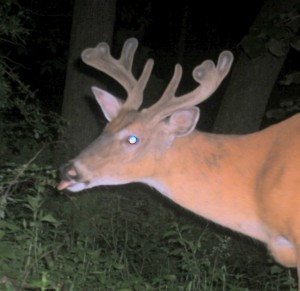 Get out and put in a little sweat equity this weekend and for the next few months to improve your hunting this fall.
Get out and put in a little sweat equity this weekend and for the next few months to improve your hunting this fall.
If you’ve got a good-sized pasture or overgrown field on the property, one of the best things you can do is mow 5 or 6 strips through the weeds, maybe 100 yards long and 20 yards wide. Leave strips of the larger and taller vegetation, like blackberries and greenbrier, between the mowed rows.
This simple task creates diversity of food and edge that whitetails love. When late-summer rains come in time for bow season, weeds and forbs pop up in the mowed strips, and deer love the new and succulent food source.
While you’re at it, hang a tree stand or two where the mowed strips intersect a wood line corner or funnel. Great spots to set up and shoot a buck feeding in the mowed strips early in the season.
Mow Some More: The natural order of does and bucks on a property will generally keep small food plots browsed down, but larger clover fields should be mowed at least once a summer with a tractor or an ATV. Cutting helps to control weeds, and the plant tops re-grow more tender and palatable.
Mow when the clover and grasses reach 10 to 12 inches tall. Mow everything down to 5 to 6 inches high.
In a year of normal temperature and rain, you’re okay to mow anytime as needed. But in a particularly hot and dry summer, don’t cut your plots too much or too short and burn them out.
Double Down on Attractants: If you’re like me, you’ve had some mineral sites scattered across your land for a couple of months, and deer are hitting them regularly. Now, with the bucks’ antlers growing fast, it’s time to double down on attractants.
One day soon, make the rounds to all your sites and refresh them with a good dose o minerals or a corn-based attractant. Hook a camera on a tree at every site and pop in a new card.
Over the next 8 weeks, return to the sites every so often, dump out more minerals and swap cards. Biologists say mid-July until the first acorns start to fall in late August is the best time to conduct a camera survey of the bucks on your land.
From the mineral sites you’ll get hundreds if not thousands of images that, when combined, give you a good idea of how many deer live on the property, and the buck-to-doe ratio. Best of all, you’ll see the older bucks and immediately know what kind of rack year it will be.
Compile and sort the images of bucks, and note the times and locations of their travels. Cross-reference this info with aerial images of the property, and the patterns of the big deer, and where to hunt them, begin to come into focus.
Prep Fall Plots: If you are planning to put in a few cool-season food plots of, say, chicory or wheat, in August or September, here are a couple of things to do now.
Disk areas where you’ll plant several times in two-week intervals prior to when you’ll sow the seeds. This will not only work the soil, but also help to reduce weeds and grass that come up later. Gather some of the fresh dirt and have it soil tested to see if you need to lime the plots. The sooner you lime, the better your fall plants will grow.
Keep a Chainsaw Handy: As you move around your property and work, keep a chainsaw gassed, oiled and ready in your truck or ATV. “It’s one of your most important tools,” says Big Deer blogger and Illinois land-management expert Matt Cheever, who recommends a saw in the 40-45 cc range with an 18-inch bar. “Buy a quality saw and it will last about 25 years of hard use on your deer land.”
You never know when you’ll need it—to remove a tree that fell into a food plot in the last wind storm, or across a logging road or ATV trail that you use to access plots. You might need to cut a rotting, dangerous tree that stands near one of your ladders or blinds.
“Every dead and fallen tree that you remove now will let you move around and hunt easier, quieter and safer when the season opens in a few months,” says Matt.






We worked up half of our food plot 3 weeks ago, about 1.5 acres and planted some Whitetail Institute Power Plant. Going to check it out this weekend and see how it looks and probably get some cameras out. Looking to plant the other half this Augusts with Alfalfa, deer love that stuff by us. Should be interesting to see how the combination works out with all the corn planted in our area.